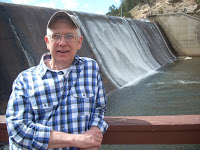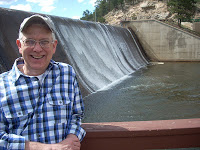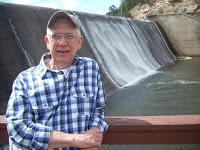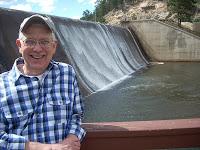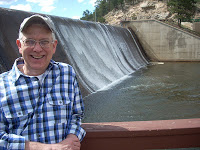I had read and thought a lot about LGBT life (I’ll call it gay in this story), observed it close at hand, knew aspects of traditions that I didn’t easily relate to. Then at age fifty-one I moved to Denver to start living the gay life in a truly gay spirit. I had initiated changing relationships with my wife and with a long career in religious leadership and moved west to secure some kind of employment. I hoped to dedicate most of my time to writing and painting. I needed work I could do for fourteen or fifteen years. I was quite excited. I ended up entering massage school figuring I could work in this therapeutic field part time to afford the rest of my life.
I did not choose massage out of an illegal motivation—meaning I did not choose it in order to have easy access to male bodies. I had given massages for years to my family and knew I could learn to do it well. I already knew how massage can help manage pain. In school I learned much more about the therapeutic effects and the techniques that made them possible. In the ensuing years I also dedicated a lot of time and effort to make massage affordable to persons living with AIDS as a kind of memorial to the life of a deceased friend.
My wife from whom I was separated but with whom I was friendly came to visit me accompanied by a woman friend we had known in another city. I wanted to introduce them to some aspects of my new life: a solo show of my art at a coffee shop, some of my new friends, the place I lived, the clubs in which I danced on weekends, the clinic where I volunteered, and so forth. On Friday night we started out to go dancing. I wanted to begin at a disco with techno music I enjoyed and to end up at a bar with Country Western music I knew they’d enjoy. On the way to the disco our friend Nancy said, “I’d really like to meet some drag queens.” I responded, “We’re headed the right direction and will make it our first stop.” We drove south on Broadway past the disco and arrived at BJ’s Carousel where I knew we could catch a drag show. I introduced Myrna and Nancy to a guy I knew who was in street clothes but who often performed there. He was funny as usual and questioned Nancy about her colors—hair, skin, and makeup. Nancy asked, “Why do you ask?” “Because your colors aren’t right,” he said without a blink. She asked for details and when the guy concluded, she said, “That’s exactly what my cosmetologist said.” My acquaintance Eric turned away from the table and with a flick of his head said back over his shoulder to her, “Come with me.” He led her to the dressing room where he and a bevy of his cronies did a simple change over.
Nancy told us later that when they entered the room everything went silent and everyone stared ice at her. “It’s okay,” Eric retorted to them, “She’s real.” Meaning “She’s no competition.” So they shared their ideas and makeup, and she emerged perfectly colored.
Eric stayed at our table for a drink and chatted on a bit about his life. He then said to Myrna, “You know, Phillip is not really gay.” She and Nancy looked just a little surprised. “I know,” he continued, “because he had beautiful me naked on his massage table and didn’t have sex!” We all laughed. I did have him on my table. He came to me because of back pain, probably related to wearing stiletto heels on weekend nights and sometimes even when he sang in the church choir on Sunday mornings. I worked my darndest to address his discomfort, and the work helped him. I was not interested to have sex not because he was unattractive or unavailable. I just didn’t operate that way. I wasn’t interested to mix sex with my practice or to play the role of an older gay prostitute. I wasn’t interested in gay sex by volume but rather I wanted it accompanied with feelings I thought of as love. Old fashioned? Whatever.
Perhaps I wasn’t gay by his standard. On the other hand he really may have been complimenting me in the presence of my wife. But probably he was just, like usual, blabbing out whatever he thought.
Still, I thought about the exchange. Was I not REALLY gay like he supposed? I knew I was—but in my own way. Not as a caricature of sexuality gone amok but rather as a thoughtful homosexual who had finally decided to simplify his life and open himself to a full measure of gay loving that reached far beyond its hormone-driven component. I knew my own gay vision would at best necessitate more than one partner, but I wasn’t interested in just any partner no matter how eager or open he might be.
When we left the drag bar, we went to the Compound to dance, then to BoyZ’s Town to see the strippers—another Nancy request. And finally we arrived at Charlie’s to dance with each other and with more gay and lesbian, trans-gender and probably bisexual folk. And I thought, what a way to celebrate: my way to celebrate my gay spirit. I knew the rightness of it for any encounter with any spirit will surprise and always resist being boxed in by definition and quantification.
© 23 January 2015, Denver
About the Author
Phillip Hoyle lives in Denver and spends his time writing, painting, and socializing. In general he keeps busy with groups of writers and artists. Following thirty-two years in church work and fifteen in a therapeutic massage practice, he now focuses on creating beauty. He volunteers at The Center leading the SAGE program “Telling Your Story.”
He also blogs at artandmorebyphilhoyle.blogspot.com
